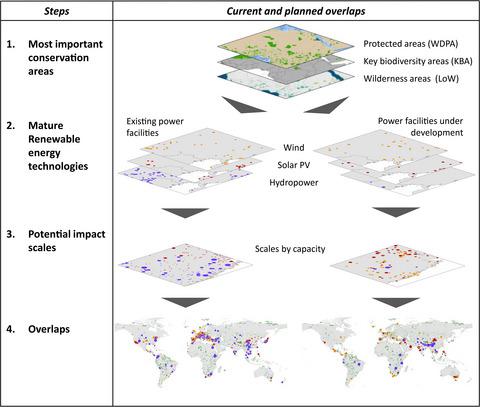当前位置:
X-MOL 学术
›
Glob. Change Biol.
›
论文详情
Our official English website, www.x-mol.net, welcomes your feedback! (Note: you will need to create a separate account there.)
Renewable energy development threatens many globally important biodiversity areas.
Global Change Biology ( IF 11.6 ) Pub Date : 2020-03-25 , DOI: 10.1111/gcb.15067 Jose A Rehbein 1, 2, 3 , James E M Watson 1, 2, 4 , Joe L Lane 3, 5 , Laura J Sonter 1, 2 , Oscar Venter 6 , Scott C Atkinson 7 , James R Allan 2, 8, 9
Global Change Biology ( IF 11.6 ) Pub Date : 2020-03-25 , DOI: 10.1111/gcb.15067 Jose A Rehbein 1, 2, 3 , James E M Watson 1, 2, 4 , Joe L Lane 3, 5 , Laura J Sonter 1, 2 , Oscar Venter 6 , Scott C Atkinson 7 , James R Allan 2, 8, 9
Affiliation

|
Transitioning from fossil fuels to renewable energy is fundamental for halting anthropogenic climate change. However, renewable energy facilities can be land‐use intensive and impact conservation areas, and little attention has been given to whether the aggregated effect of energy transitions poses a substantial threat to global biodiversity. Here, we assess the extent of current and likely future renewable energy infrastructure associated with onshore wind, hydropower and solar photovoltaic generation, within three important conservation areas: protected areas (PAs), Key Biodiversity Areas (KBAs) and Earth's remaining wilderness. We identified 2,206 fully operational renewable energy facilities within the boundaries of these conservation areas, with another 922 facilities under development. Combined, these facilities span and are degrading 886 PAs, 749 KBAs and 40 distinct wilderness areas. Two trends are particularly concerning. First, while the majority of historical overlap occurs in Western Europe, the renewable electricity facilities under development increasingly overlap with conservation areas in Southeast Asia, a globally important region for biodiversity. Second, this next wave of renewable energy infrastructure represents a ~30% increase in the number of PAs and KBAs impacted and could increase the number of compromised wilderness areas by ~60%. If the world continues to rapidly transition towards renewable energy these areas will face increasing pressure to allow infrastructure expansion. Coordinated planning of renewable energy expansion and biodiversity conservation is essential to avoid conflicts that compromise their respective objectives.
中文翻译:

可再生能源发展威胁着许多全球重要的生物多样性地区。
从化石燃料过渡到可再生能源是制止人为气候变化的基础。但是,可再生能源设施可能是土地利用密集型的地区,并且会影响到保护区,并且很少关注能源转换的综合影响是否对全球生物多样性构成重大威胁。在这里,我们评估了三个重要的保护区域内与陆上风能,水力发电和太阳能光伏发电相关的当前和未来可能的可再生能源基础设施的范围:保护区(PAs),关键生物多样性区(KBA)和地球上其余的荒野。我们在这些保护区的边界内确定了2206个可运行的可再生能源设施,另外922个正在开发中。结合起来 这些设施跨越并且正在使886 PA,749 KBA和40个不同的荒野地区退化。有两个趋势值得关注。首先,虽然大多数历史重叠发生在西欧,但正在开发的可再生电力设施与东南亚的保护区重叠越来越多,而东南亚是全球生物多样性的重要地区。其次,下一波可再生能源基础设施浪潮表示受影响的PA和KBA数量增加了约30%,并且可能使受灾荒野地区的数量增加约60%。如果世界继续迅速向可再生能源过渡,这些地区将面临越来越大的压力,要求扩大基础设施。
更新日期:2020-04-22
中文翻译:

可再生能源发展威胁着许多全球重要的生物多样性地区。
从化石燃料过渡到可再生能源是制止人为气候变化的基础。但是,可再生能源设施可能是土地利用密集型的地区,并且会影响到保护区,并且很少关注能源转换的综合影响是否对全球生物多样性构成重大威胁。在这里,我们评估了三个重要的保护区域内与陆上风能,水力发电和太阳能光伏发电相关的当前和未来可能的可再生能源基础设施的范围:保护区(PAs),关键生物多样性区(KBA)和地球上其余的荒野。我们在这些保护区的边界内确定了2206个可运行的可再生能源设施,另外922个正在开发中。结合起来 这些设施跨越并且正在使886 PA,749 KBA和40个不同的荒野地区退化。有两个趋势值得关注。首先,虽然大多数历史重叠发生在西欧,但正在开发的可再生电力设施与东南亚的保护区重叠越来越多,而东南亚是全球生物多样性的重要地区。其次,下一波可再生能源基础设施浪潮表示受影响的PA和KBA数量增加了约30%,并且可能使受灾荒野地区的数量增加约60%。如果世界继续迅速向可再生能源过渡,这些地区将面临越来越大的压力,要求扩大基础设施。



























 京公网安备 11010802027423号
京公网安备 11010802027423号